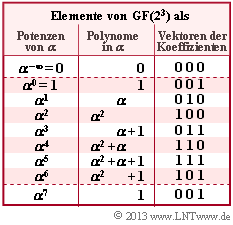Difference between revisions of "Aufgaben:Exercise 2.5Z: Some Calculations about GF(2 power 3)"
From LNTwww
| Line 22: | Line 22: | ||
''Hinweis:'' | ''Hinweis:'' | ||
* Die Aufgabe bezieht sich auf das Kapitel [[Kanalcodierung/Erweiterungsk%C3%B6rper| Erweiterungskörper]] und ist als Ergänzung zur etwas schwierigeren [[Aufgaben:2.5_Drei_Varianten_von_GF(2%5E4)|Aufgabe A2.5]] gedacht. | * Die Aufgabe bezieht sich auf das Kapitel [[Kanalcodierung/Erweiterungsk%C3%B6rper| Erweiterungskörper]] und ist als Ergänzung zur etwas schwierigeren [[Aufgaben:2.5_Drei_Varianten_von_GF(2%5E4)|Aufgabe A2.5]] gedacht. | ||
| + | |||
| Line 27: | Line 28: | ||
===Fragebogen=== | ===Fragebogen=== | ||
<quiz display=simple> | <quiz display=simple> | ||
| − | { | + | {Welche der Aussagen treffen für die höheren Potenzen von $\alpha$ zu $(i ≥ 7)$? |
|type="[]"} | |type="[]"} | ||
| − | + | + | + $\alpha^7 = 1$, |
| − | + | + $\alpha^8 = \alpha$, | |
| + | + $\alpha^13 = \alpha^2 + 1$, | ||
| + | + $\alpha^i = \alpha^{i \ \rm mod \, 7}$. | ||
| − | { | + | {Welche Umformung ist für $A = \alpha^8 + \alpha^6 - \alpha^2 + 1$ zulässig? |
|type="[]"} | |type="[]"} | ||
| − | + | + | - $A = 1$, |
| − | - | + | + $A = \alpha$, |
| + | - $A = \alpha^2$, | ||
| + | - $A = \alpha^3$, | ||
| + | - $A = \alpha^4$. | ||
| − | { | + | {Welche Umformung ist für $B = \alpha^{16} - \alpha^{12} \cdot \alpha^3$ zulässig? |
|type="[]"} | |type="[]"} | ||
| − | + | - $B = 1$, | |
| − | - | + | - $B = \alpha$, |
| + | - $B = \alpha^2$, | ||
| + | - $B = \alpha^3$, | ||
| + | + $B = \alpha^4$. | ||
| − | { | + | {Welche Umformung ist für $C = \alpha^3 + \alpha$ zulässig? |
|type="[]"} | |type="[]"} | ||
| − | + | + | + $C = 1$, |
| − | - | + | - $C = \alpha$, |
| + | - $C = \alpha^2$, | ||
| + | - $C = \alpha^3$, | ||
| + | - $C = \alpha^4$. | ||
| − | { | + | {Welche Umformung ist für $D = \alpha^4 + \alpha$ zulässig? |
|type="[]"} | |type="[]"} | ||
| − | + | + | - $D = 1$, |
| − | - | + | - $D = \alpha$, |
| + | + $D = \alpha^2$, | ||
| + | - $D = \alpha^3$, | ||
| + | - $D = \alpha^4$. | ||
| − | { | + | {Welche Umformung ist für $E = A \cdot B \cdot C/D$ zulässig? |
|type="[]"} | |type="[]"} | ||
| − | + | + | - $E = 1$, |
| − | - | + | - $E = \alpha$, |
| + | - $E = \alpha^2$, | ||
| + | + $E = \alpha^3$, | ||
| + | - $E = \alpha^4$. | ||
| − | { | + | {Welche Aussagen gelten für die multiplikative Inverse zu $\alpha^2 + \alpha$? |
|type="[]"} | |type="[]"} | ||
| − | + | + | - ${\rm Inv_M}(\alpha^2 + \alpha) = 1$, |
| − | - | + | + ${\rm Inv_M}(\alpha^2 + \alpha) = \alpha + 1$, |
| + | + ${\rm Inv_M}(\alpha^2 + \alpha) = \alpha^3$, | ||
| + | - ${\rm Inv_M}(\alpha^2 + \alpha) = \alpha^4$. | ||
</quiz> | </quiz> | ||
Revision as of 22:01, 15 December 2017
Wir betrachten nun den Erweiterungskörper (englisch: Extension Field) mit den acht Elementen ⇒ $\rm GF(2^3)$ entsprechend der nebenstehenden Tabelle. Da das zugrunde liegende Polynom
- $$p(x) = x^3 + x +1 $$
sowohl irreduzibel als auch primitiv ist, kann das vorliegende Galoisfeld in folgender Form angegeben werden:
- $${\rm GF}(2^3) = \{\hspace{0.1cm}0\hspace{0.05cm},\hspace{0.1cm} 1,\hspace{0.05cm}\hspace{0.1cm} \alpha\hspace{0.05cm},\hspace{0.1cm} \alpha^{2}\hspace{0.05cm},\hspace{0.1cm} \alpha^{3}\hspace{0.05cm},\hspace{0.1cm} \alpha^{4}\hspace{0.05cm},\hspace{0.1cm} \alpha^{5}\hspace{0.05cm},\hspace{0.1cm} \alpha^{6}\hspace{0.1cm}\}\hspace{0.05cm}. $$
Das Element $\alpha$ ergibt sich dabei als Lösung der Gleichung $p(\alpha) = 0$ im Galoisfeld $\rm GF(2)$. Damit erhält man folgende Nebenbedingung:
- $$\alpha^3 + \alpha +1 = 0\hspace{0.3cm} \Rightarrow\hspace{0.3cm} \alpha^3 = \alpha +1\hspace{0.05cm}.$$
Für die weiteren Elemente gelten folgende Berechnungen:
- $$\alpha^4 \hspace{-0.15cm} \ = \ \hspace{-0.15cm} \alpha \cdot \alpha^3 = \alpha \cdot (\alpha + 1) = \alpha^2 + \alpha \hspace{0.05cm},$$
- $$\alpha^5 \hspace{-0.15cm} \ = \ \hspace{-0.15cm} \alpha \cdot \alpha^4 = \alpha \cdot (\alpha^2 +\alpha) = \alpha^3 + \alpha^2 = \alpha^2 + \alpha + 1\hspace{0.05cm},$$
- $$\alpha^6 \hspace{-0.15cm} \ = \ \hspace{-0.15cm} \alpha \cdot \alpha^5 = \alpha \cdot (\alpha^2 +\alpha + 1)= \alpha^3 + \alpha^2 + \alpha= \alpha + 1 + \alpha^2 + \alpha = \alpha^2+ 1\hspace{0.05cm}.$$
In dieser Aufgabe sollen Sie einige algebraische Umformungen in diesem Galoisfeld $\rm GF(2^3)$ vornehmen. Unter anderem ist gefragt nach der multiplikativen Inversen des Elementes $\alpha^4$. Dann muss gelten:
- $$\alpha^4 \cdot {\rm Inv_M}( \alpha^4) = 1 \hspace{0.05cm}.$$
Hinweis:
- Die Aufgabe bezieht sich auf das Kapitel Erweiterungskörper und ist als Ergänzung zur etwas schwierigeren Aufgabe A2.5 gedacht.
Fragebogen
Musterlösung
(1)
(2)
(3)
(4)
(5)
